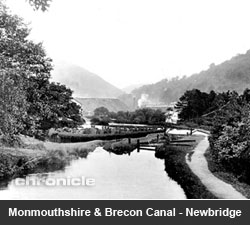
Canals
Over two hundred years ago, the entrepreneurs of the industrial revolution saw the potential of inland waterways for transporting goods cheaply and efficiently throughout Britain. They developed an inland waterway network linking mines and quarries with factories, mills, markets, and ports.
The "canal mania" reached Wales in the last years of the 18th Century and led to the expenditure of vast sums of money to overcome the difficulties presented by Welsh terrain. The Glamorganshire Canal, begun in 1792, linked Merthyr and Aberdare with Cardiff. Others followed in quick succession.
The iron and other industrial centres in South Wales were poorly placed for the transportation of their goods to the ports. Initially, pig iron was carried to the coast by packhorses bearing panniers. Roads were eventually built but, while a wagon drawn by four horses could convey two tons of goods, a canal barge drawn by one horse could convey twenty-five tons.
What is nowadays popularly referred to as the 'Mon & Brec' started life as two separate canals: the Brecknock & Abergavenny Canal, and the Monmouthshire Canal. In the 1790s, the Monmouthshire Canal Company received its Act of Parliament at the same time that the Brecknock & Abergavenny was being planned. Following discussions, it was decided to link the two at Pontymoile by 1812. By this time the section of the Monmouthshire from Pontymoile north-westwards to Pontnewynydd was already looking short-lived and by the 1850s it had already been supplanted by a railway. After the closure of the bottom end of the Monmouthshire, the rest of the Monmouth & Brecon canal was maintained principally as a water feeder for Newport docks.
Both canals, supported by horsedrawn tramroads, were used primarily to haul coal, limestone and iron ore from the hillsides. In 1880 the canals were taken over by the Great Western Railway - a revered name among railway enthusiasts but not a great benefactor of the canals. Within 35 years, commercial carrying had all but ceased.
Throughout the 20th Century various parts of the Monmouthshire Canal and its Crumlin Arm were filled in for road construction. The line was all but obliterated through Cwmbran and was effectively unnavigable further north. Vigorous campaigning by canal enthusiasts heralded a new dawn for the canal and in 1968, restoration work from Brecon to Pontymoile began in earnest.
The unique Fourteen Locks are part of the Crumlin Arm, carrying the canal approximately 168 ft in less than 900 yards using a series of pounds and ponds to conserve as much water as possible.
There were 32 locks and two tunnels (Cwmbran and Barrack Hill, Newport) on the Monmouthshire main line, plus 32 locks on the Crumlin branch. On the B&A there were six locks (one at Brynich and five at Llangynidr) and Ashford Tunnel. Potter Street Lock in Newport was already out of use and in filled before the numbering system of the amalgamated canals so there are now 69 locks in all.
Nowadays the 'Mon & Brec' canal is thriving with thousands of leisure visitors every year.
Image date: unknown
Location: unknown
Submitted by: unknown
Do you have any stories, images and interesting facts relating to this picture. Help Chronicle build a website of your Caerphilly County Borough memories. Email the webmaster telling us as much as you can about your pictures. Thank you
Description: